Best Chatbot and Live Chat Tools to Enhance Customer Engagement

In today’s fast-paced world, customers expect instant solutions. When comparing live chat vs chatbot, both tools have transformed how you can deliver customer service. These AI-powered solutions quickly answer questions, automate repetitive tasks, and handle multiple queries at once. This not only improves customer engagement but also reduces operational costs by up to 35%. Imagine providing seamless support while saving time and money—it’s a game changer! With 80% of businesses adopting AI chatbots by 2025, tools like Sobot are helping companies enhance service efficiency and grow their bottom line.
Why Chatbots and Live Chat Tools Matter
Benefits of Chatbots for Customer Engagement
Chatbots have become a game-changer for businesses looking to enhance customer engagement. These tools are available 24/7, ensuring your customers can get help anytime they need it. They handle simple queries instantly, which means faster resolutions and happier customers. In fact, chatbots can respond to inquiries five times faster than human representatives. This speed not only improves satisfaction but also lowers the Customer Effort Score (CES), making it easier for customers to navigate your support resources.
You might be surprised to learn how effective chatbots can be. For example:
- Sephora's chatbot handled over 70 million conversations, boosting click-through rates by 200-300% and increasing basket sizes.
- Taco Bell's Tacobot automated ordering processes, leading to a 20% increase in average order value.
Chatbots also excel at proactive engagement. They can send updates about order statuses, collect feedback after interactions, and even engage in real-time conversations across multiple channels. With 70% of millennials reporting positive experiences with chatbots, it’s clear these tools are here to stay.
Advantages of Live Chat for Real-Time Support
Live chat ai tools are perfect for delivering real-time support. They let you connect with customers instantly, which is crucial when someone needs help while browsing your website. Did you know that 63% of customers are more likely to make a purchase from websites with live chat? That’s a huge opportunity for your business.
Here’s how live chat stands out:
- Businesses using live chat report a 20% increase in website conversions.
- 87% of live chat interactions receive positive customer satisfaction ratings.
- Customers love fast replies, with 84.7% satisfied when responses come within 5-10 seconds.
Live chat also boosts retention. Around 60% of customers are more likely to return to a website that offers this feature. It’s not just about solving problems; it’s about building loyalty and trust.
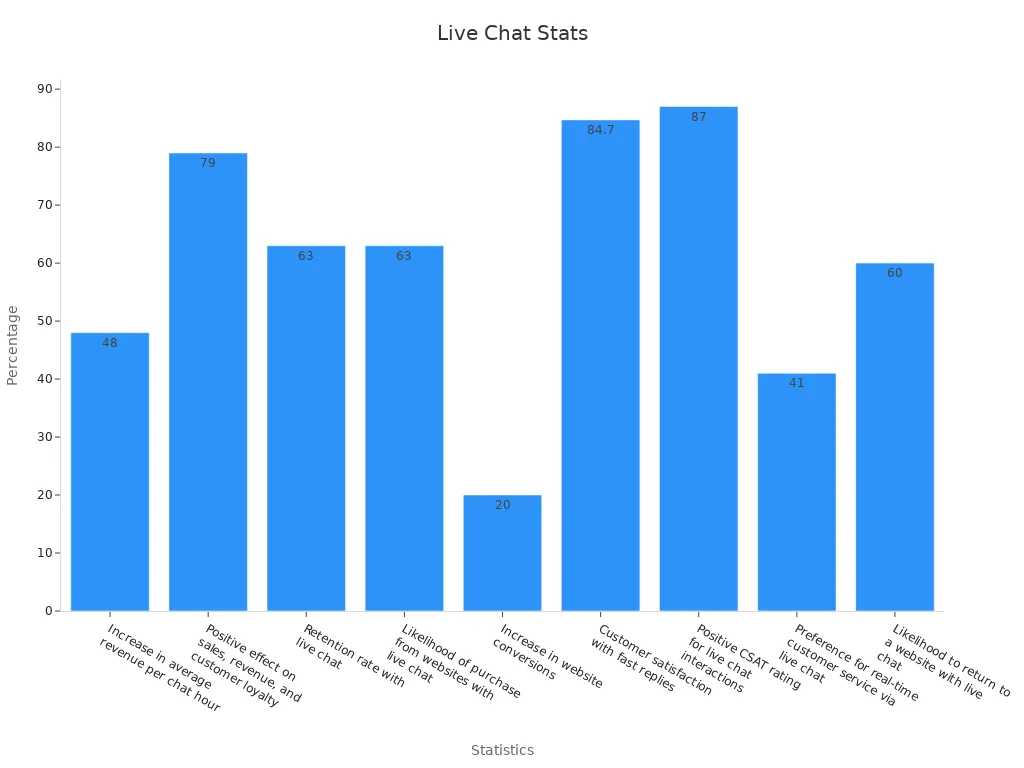
The Role of AI and Automation in Customer Service
AI and automation are transforming customer service. They allow you to provide personalized experiences at scale, which is something traditional methods can’t achieve. For instance, Sephora uses AI to recommend products, resulting in a 20% increase in repeat purchases. Similarly, Nike’s AI agent delivers tailored content, boosting direct-to-consumer sales by 30%.
Automation also improves efficiency. AI-powered chatbots can handle repetitive tasks, freeing up your team to focus on complex issues. KLM Royal Dutch Airlines, for example, introduced an AI chatbot for 24/7 support, enhancing both efficiency and satisfaction. These tools don’t just save time—they elevate the entire customer experience.
By integrating conversational AI into your strategy, you can meet customer expectations while streamlining operations. Whether it’s through chatbots or live chat ai tools, the combination of AI and automation is a win-win for you and your customers.
How These Tools Drive Business Growth
When you think about growing your business, tools like chatbots and live chat can make a huge difference. They don’t just improve customer support—they also boost sales, save costs, and build loyalty. Let’s break it down.
First, chatbots are incredible for handling repetitive tasks. They free up your team to focus on more complex issues, which means better service for your customers. Plus, they’re available 24/7, so you never miss an opportunity to engage. Businesses using chatbots saved an average of $300,000 in 2019. That’s money you can reinvest into other areas of your business.
Live chat, on the other hand, is a game-changer for conversions. Imagine a customer browsing your website and needing help. With live chat, they get instant support, which makes them more likely to buy. In fact, adding live chat can improve conversions by 12%. It’s like having a friendly salesperson available at all times.
Here’s a quick look at how these tools drive growth:
| Statistic | Impact on Business Growth |
|---|---|
| 79% of businesses report positive impact on sales, revenue, and loyalty | Indicates that live chat features are beneficial for customer retention and financial performance. |
| Live chat can improve conversions by 12% | Highlights the effectiveness of live chat in turning visitors into customers, crucial for e-commerce success. |
| Organizations using chatbots saved an average of $300,000 in 2019 | Shows cost savings associated with chatbots, contributing to overall business efficiency and profitability. |
| 38% of consumers are more likely to buy from companies offering live chat | Suggests that having live chat support can enhance customer purchasing decisions, boosting sales potential. |
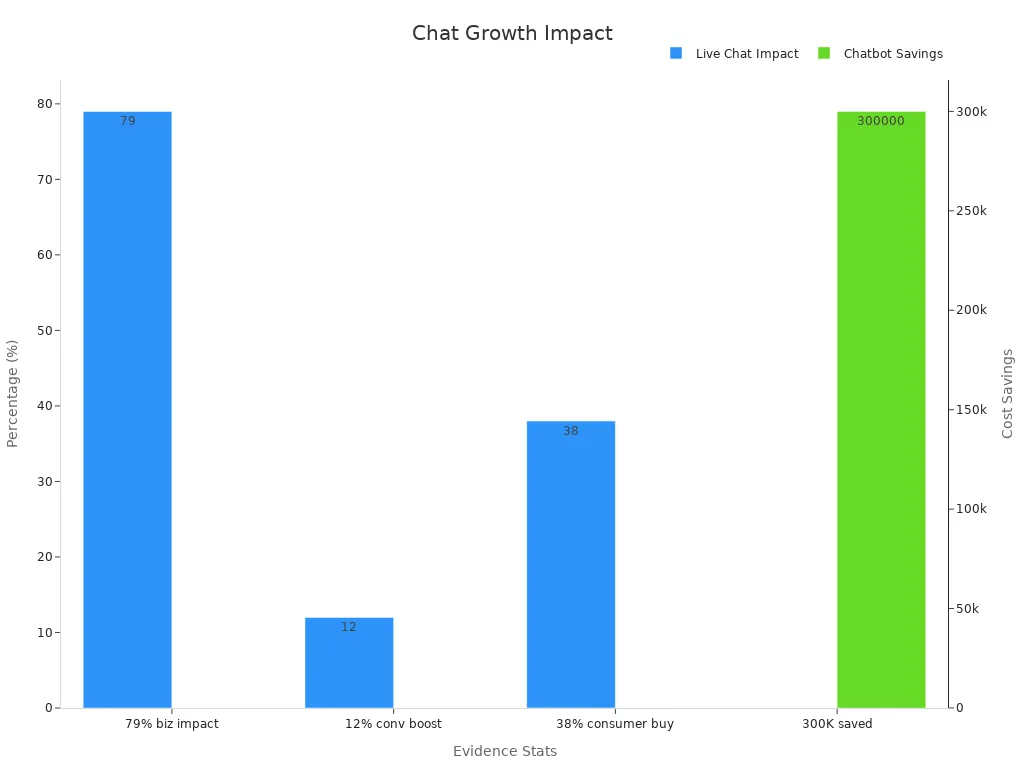
AI and automation also play a big role here. With conversational AI, you can personalize interactions at scale. This makes customers feel valued, which keeps them coming back. For example, 79% of businesses say live chat features positively impact sales, revenue, and loyalty. That’s a clear sign these tools aren’t just helpful—they’re essential.
By combining chatbots, live chat, and AI, you create a seamless experience for your customers. These tools don’t just solve problems; they help you grow your business in ways you never thought possible.
Top Chatbot and Live Chat Tools for 2025

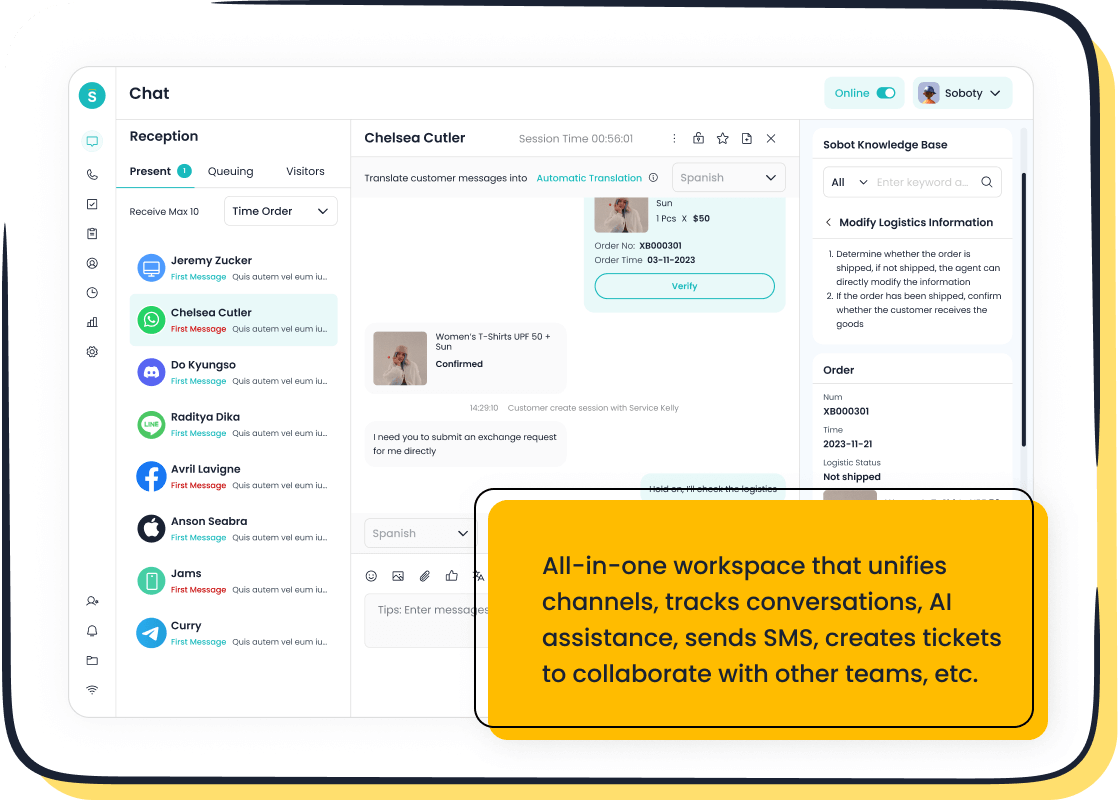
Sobot Live Chat - Features, Pricing, and Use Cases
If you're looking for the best live chat tool to enhance customer engagement, Sobot Live Chat is a standout choice. This platform offers a seamless way to connect with your customers across multiple channels, including websites, apps, and social media platforms like WhatsApp, Facebook, and Instagram. With its omnichannel support, you can ensure no customer query goes unanswered.
Sobot Live Chat is packed with features designed to boost efficiency and customer satisfaction. It uses AI-powered tools to assist agents, enabling faster responses and personalized interactions. The platform also includes built-in analytics, allowing you to track over 150 indicators and make data-driven decisions. Plus, its customizable widgets ensure the chat interface aligns with your brand image.
One of the most impressive aspects of Sobot Live Chat is its ability to increase conversion rates by 38%. By using precise profiling and tailored services, it turns visitors into loyal customers. For example, businesses using Sobot have reported significant improvements in customer support and sales. And with a free trial available, you can experience its benefits firsthand.
Pro Tip: Sobot Live Chat integrates seamlessly with other systems, making it easier for your team to collaborate and provide top-notch service.
Learn more about Sobot Live Chat here.
ChatGPT - Best for Complex Tasks
When it comes to handling complex tasks, ChatGPT stands out as the best overall AI chatbot. This AI chatbot platform excels in providing instant, personalized customer service. Whether you're automating routine tasks or offering detailed product recommendations, ChatGPT delivers high-quality responses that enhance customer satisfaction.
Users have praised ChatGPT for its quick response times and ability to solve problems in real-time. For instance, businesses have used it to automate customer service tasks, saving time and resources. Its effectiveness in information retrieval makes it a valuable tool for both academic and professional tasks. Imagine having a chatbot that not only answers questions but also helps you meet your business goals.
Here’s a quick look at why ChatGPT is a top choice:
- Automates routine customer service tasks, freeing up your team for more critical issues.
- Provides just-in-time learning, allowing users to solve problems instantly.
- Delivers high-quality, personalized responses that build trust and loyalty.
| Evidence Type | Description |
|---|---|
| Application | Used in virtual assistants and chatbots for instant, personalized service. |
| User Feedback | Outperforms other tools in completing academic and professional tasks. |
| Response Speed | Enhances productivity with quick, accurate replies. |
ChatGPT’s ability to handle complex queries makes it an essential tool for businesses aiming to improve customer support and engagement.
Drift - Ideal for Sales and Marketing
Drift is a game-changer for businesses focused on sales and marketing. This platform specializes in conversational marketing, helping you engage with prospects in real-time. Drift’s tools are designed to optimize conversions, making it easier to turn website visitors into leads.
One of Drift’s standout features is its analytics capabilities. You can track engagement levels, measure the effectiveness of interactions, and refine your sales strategies. For example, businesses using Drift have reported improved lead response times and higher conversion rates. Its real-time interaction tracking ensures you’re always one step ahead in understanding customer needs.
| Metric | Description |
|---|---|
| Conversion Rates | Tracks how chat experiences convert prospects to leads. |
| Engagement | Measures interaction levels for better campaign planning. |
| Lead Response Time | Improves sales efficiency by engaging leads faster. |
| Effectiveness of Interactions | Enhances customer satisfaction through personalized conversations. |
Drift’s tailored reports and actionable insights make it a valuable asset for businesses looking to maximize their marketing ROI. If you’re aiming for growth, this platform can help you achieve it.
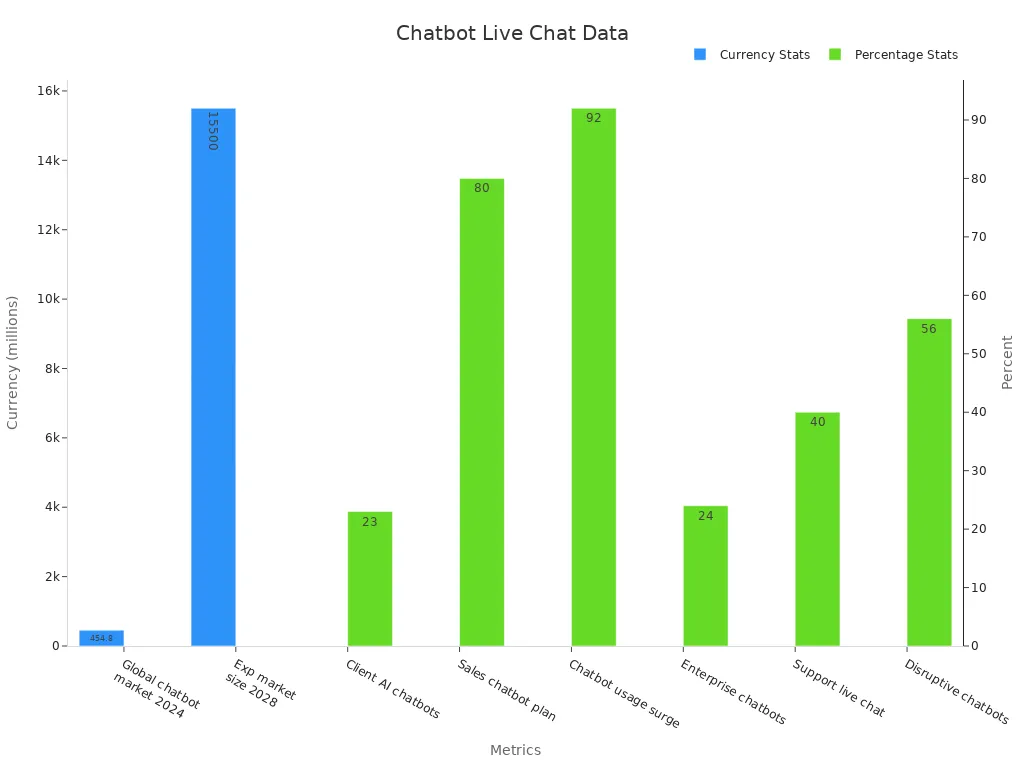
Tidio - Best for E-commerce and Small Businesses
Tidio is a fantastic choice if you're running an e-commerce store or a small business. This live chat software combines simplicity with powerful features, making it easy for you to connect with your customers. Whether you're looking to reduce cart abandonment or improve response times, Tidio has you covered.
One of the standout features of Tidio is its ability to create a personalized shopping experience. Think of it as having a virtual assistant for your online store. For example, Ad Hoc Atelier, an Italian e-commerce platform, used Tidio to transform its customer engagement. They saw their conversion rate jump from 0.35% to 0.9%, while their cart abandonment rate dropped from 83% to 73%. Even better, their average response time improved from 3 hours to just 1 minute. These results show how Tidio can make a real difference for your business.
Tidio also integrates seamlessly with other tools, allowing you to manage customer interactions across multiple channels. Its AI-powered chatbot can handle repetitive queries, freeing up your time to focus on more complex tasks. If you're looking for the best live chat software to boost your e-commerce success, Tidio is a tool worth exploring.
Intercom - Unified Support Across Platforms
Intercom is a platform designed to unify your customer support, sales, and marketing efforts. It’s perfect if you want to provide consistent and personalized service across multiple channels. By using first-party data, Intercom creates a single customer record, breaking down silos and enabling your teams to collaborate more effectively.
One of Intercom's most impressive features is its Inbox. This tool consolidates all customer interactions—whether they come from website chat, email, or social media—into one place. Imagine how much easier it would be to manage inquiries when everything is centralized. You’ll never miss a message, and your customers will appreciate the quick responses.
Intercom also integrates with tools like Medallia to deliver a seamless customer experience. Businesses using this platform have transformed disjointed interactions into unified, meaningful engagements. If you're looking for a platform that simplifies support while enhancing customer satisfaction, Intercom is a strong contender.
Zoho SalesIQ - Enhancing Customer Support and Sales
Zoho SalesIQ is a versatile platform that helps you engage with your customers throughout their journey. It’s packed with features that enhance both customer support and sales processes, making it a great choice for businesses of all sizes.
With Zoho SalesIQ, you can proactively engage with visitors on your website. The platform’s live chat feature allows you to start conversations at the right time, increasing the chances of conversion. It also collects feedback from customers, helping you identify areas for improvement. For example, you can schedule performance reports to monitor your team’s effectiveness and make data-driven decisions.
Advanced analytics is another highlight of Zoho SalesIQ. You can track key metrics like website traffic sources and visitor behavior, giving you valuable insights to optimize your marketing strategies. Whether you’re looking to improve lead generation or enhance the user experience, Zoho SalesIQ provides the tools you need to succeed.
ManyChat - Best for Social Media Engagement
If your business thrives on social media, ManyChat is the perfect platform to boost your engagement. This chatbot platform is designed to help you connect with your audience on channels like Facebook Messenger, Instagram, and WhatsApp. It’s all about making those interactions seamless, personal, and effective.
ManyChat stands out because it’s incredibly user-friendly. You don’t need to be a tech wizard to set it up. Its drag-and-drop interface lets you create chat flows in minutes. Whether you’re automating responses to FAQs or sending personalized messages, this platform makes it easy. Plus, it integrates with popular tools like Shopify, Mailchimp, and Google Sheets, so you can streamline your workflows.
Here’s why ManyChat is a game-changer for social media engagement:
- Automated Conversations: ManyChat’s AI-powered chatbot handles repetitive tasks like answering common questions or confirming orders. This frees up your time to focus on more complex customer support needs.
- Personalized Messaging: You can send tailored messages based on user behavior. For example, if someone abandons their cart, ManyChat can send a friendly reminder to complete the purchase.
- Lead Generation: ManyChat helps you capture leads directly from social media platforms. With interactive chat flows, you can guide users through a sales funnel without them ever leaving the app.
Pro Tip: Use ManyChat’s analytics to track engagement and optimize your campaigns. You’ll gain insights into what works and what doesn’t, helping you refine your strategy.
One of the best things about ManyChat is its ability to scale. Whether you’re a small business or a large enterprise, this platform grows with you. It supports businesses of all sizes by automating customer interactions and providing 24/7 service. Imagine having a chatbot that works tirelessly to keep your customers happy and engaged.
ManyChat also excels at creating interactive experiences. For instance, you can use it to run quizzes, polls, or giveaways on social media. These activities not only engage your audience but also build brand loyalty. And with AI driving the platform, you can ensure every interaction feels natural and human-like.
Here’s a quick look at what ManyChat offers:
| Feature | Benefit |
|---|---|
| Drag-and-Drop Interface | Easy setup and customization without coding skills. |
| Omnichannel Support | Engage customers on Facebook, Instagram, WhatsApp, and more. |
| AI-Powered Automation | Handle repetitive tasks and provide instant responses. |
| Integration with Tools | Connect with Shopify, Mailchimp, and other platforms for efficiency. |
| Analytics and Insights | Track performance and optimize your campaigns for better results. |
ManyChat isn’t just a chatbot platform; it’s a complete solution for social media engagement. It helps you build meaningful relationships with your audience while saving time and resources. If you’re looking to take your social media strategy to the next level, ManyChat is the tool you need.
Live Chat vs Chatbot: Which is Right for Your Business?
Key Differences Between Live Chat and Chatbots
Choosing between live chat and chatbots depends on your business needs. Both tools offer unique advantages, but they serve different purposes. Let’s break it down:
| Criteria | Chatbot | Live Chat |
|---|---|---|
| Human Interaction | Automated responses; limited personalization. | Real-time communication with human agents for personalized support. |
| Availability | 24/7 availability, ensuring quick customer support anytime. | Limited by staffing schedules; available during business hours. |
| Scalability | Handles thousands of queries simultaneously. | Depends on the number of available agents. |
| Cost | Lower operational costs due to automation. | Higher costs because of human staffing. |
| Complexity of Queries | Best for simple or moderate queries. | Ideal for complex, nuanced issues requiring human understanding. |
| Response Time | Instant responses with minimal delay. | Quick, but depends on agent availability and workload. |
Chatbots excel in automation and scalability, while live chat shines in personalized, human-driven interactions. For example, if you need 24/7 availability to handle repetitive inquiries, chatbots are your go-to. On the other hand, live chat is perfect for resolving complex issues that require empathy and understanding.
When to Use Live Chat for Customer Support
Live chat is your best bet when customers need personalized assistance. Imagine a customer browsing your website and struggling to find the right product. A live chat agent can step in, offer tailored recommendations, and even upsell. This human touch builds trust and loyalty.
Businesses often use live chat during peak hours to handle high volumes of inquiries. It’s especially effective for industries like e-commerce, where quick responses can prevent cart abandonment. Did you know that 63% of customers are more likely to return to a website offering live chat? That’s a huge win for customer retention.
Live chat also works well for multichannel support. By integrating it with platforms like WhatsApp or Facebook Messenger, you can engage customers wherever they are. This approach not only improves accessibility but also enhances the overall customer experience.
When to Use Chatbots for Automation and Scalability
Chatbots are ideal for businesses aiming to scale their customer service automation. They handle repetitive tasks like answering FAQs, tracking orders, or providing basic troubleshooting. This frees up your team to focus on more complex issues.
For instance, companies using chatbots have reported a 60% reduction in first reply time and an 80% increase in one-touch resolution rates. These metrics highlight how chatbots improve efficiency while maintaining customer satisfaction. Plus, their 24/7 availability ensures you never miss a query, even outside business hours.
Chatbots also shine in data collection. They gather insights from customer interactions, helping you refine your strategies. Whether it’s through AI-driven recommendations or automated workflows, chatbots make scaling your support effortless.
Pro Tip: Combine chatbots with live chat for maximum efficiency. Let chatbots handle simple queries and escalate complex ones to human agents. This hybrid approach ensures seamless service and happy customers.
Combining Both for Maximum Efficiency
Why choose between live chat and chatbots when you can have the best of both worlds? Combining these tools creates a powerhouse for customer engagement. You get the speed and scalability of chatbots paired with the human touch of live chat. This hybrid approach ensures your customers always feel supported, no matter the complexity of their needs.
Here’s how it works. Chatbots handle the repetitive stuff—like answering FAQs or tracking orders. They’re available 24/7, so your customers never have to wait. When a question gets too tricky, the chatbot seamlessly transfers the conversation to a live agent. This handoff feels natural and keeps the customer experience smooth.
The benefits of this combo are huge. Take a look at some real-world results:
| Metric/Case Study | Evidence/Outcome |
|---|---|
| Issue Resolution Efficiency | 53% of issues resolved in a single interaction |
| E-commerce Conversion Rate Boost | Live chat can increase conversion rates by 40% |
| Operational Efficiency | Integration with CRM systems lowers acquisition costs |
Imagine running an e-commerce store. A chatbot can greet visitors, answer basic questions, and recommend products. If a customer needs help choosing between two items, a live agent can step in and provide personalized advice. This teamwork not only boosts conversions but also builds trust.
Pro Tip: Use chatbots to collect customer data before transferring to live chat. This saves time and helps agents provide faster, more tailored responses.
By combining live chat and chatbots, you create a system that’s efficient, scalable, and customer-friendly. It’s like having the perfect tag team—one that works tirelessly to keep your customers happy and your business thriving. Why settle for one when you can have both? 😊
How to Choose the Right Tool
Choosing the right chatbot or live chat tool can feel overwhelming with so many options available. But don’t worry—breaking it down into a few key steps can make the process much easier. Let’s explore how you can assess your needs, evaluate features, and ensure the tool fits your budget and growth plans.
Assessing Your Business Needs
Start by asking yourself: What do you want this tool to achieve? Are you looking to improve customer support, automate repetitive tasks, or boost sales? Defining your goals will help you narrow down your options. For example, if your focus is on scaling customer service, a chatbot with AI capabilities like Sobot’s AI-powered solutions can handle high volumes of queries while maintaining quality.
It’s also important to consider your industry and use cases. McKinsey highlights three categories of use cases: top-line (like improving customer-facing activities), bottom-line (enhancing internal processes), and new business models (launching innovative services). For instance, if you’re in e-commerce, tools that reduce cart abandonment or provide personalized recommendations will be a game-changer.
| Use Case Category | Description |
|---|---|
| Top-line use cases | Focus on improving customer-facing activities such as pricing, churn prevention, and recommendation engines. |
| Bottom-line use cases | Enhance internal processes through data-driven insights, including supply chain optimization and fraud prevention. |
| New business model use cases | Analyze data to launch new business offerings, services, or products. |
Think about your customers too. Do they prefer instant responses or human interaction? If your audience values speed, a chatbot with 24/7 availability is ideal. On the other hand, live chat works better for complex queries requiring empathy. Tools like Sobot Live Chat combine both, offering a hybrid approach that ensures no customer is left waiting.
Pro Tip: Map out your customer journey to identify pain points. This will help you choose a tool that addresses specific challenges effectively.
Evaluating Features and Integrations
Once you’ve identified your needs, it’s time to dive into the features. Look for tools that align with your goals and offer the flexibility to grow with your business. For example, Sobot Live Chat provides omnichannel support, AI-assisted tools, and built-in analytics, making it a versatile choice for businesses of all sizes.
Here are some key features to evaluate:
- Behavior Analysis and Reporting: Understanding customer interactions is crucial for improving service.
- Third-Party Integrations: Tools that integrate with your CRM, email marketing software, or e-commerce platform can streamline workflows.
- Customization Options: A customizable interface ensures the tool matches your brand identity.
- Scalability and Security: Ensure the tool complies with regulations like GDPR and offers robust security measures.
| Evaluation Criteria | Description |
|---|---|
| Pricing | Cost and available plans, including commitment terms. |
| Free plan or trial | Availability of a trial period to test the software. |
| Customer service and support | Assistance options for users. |
| Review score | User ratings from review sites. |
| Notable features | Unique features that differentiate the software. |
For example, Sobot’s integration capabilities allow you to connect with platforms like WhatsApp, Facebook, and Instagram. This ensures seamless communication across channels, which is essential for delivering consistent customer experiences.
Note: Don’t overlook ease of use. A tool with a steep learning curve can slow down your team’s productivity.
Considering Budget and Scalability
Finally, think about your budget. While it’s tempting to go for the cheapest option, remember that quality matters. A tool that saves you time and improves efficiency will pay for itself in the long run. Look for pricing plans that match your business size and growth trajectory.
Scalability is equally important. As your business grows, your customer base will too. You’ll need a tool that can handle increased demand without compromising performance. Sobot’s solutions, for instance, are designed to scale effortlessly, supporting over 6 million online communications daily with 99.99% system stability.
Here’s a quick checklist to guide your decision:
- Does the tool offer flexible pricing plans?
- Is there a free trial to test its features?
- Can it scale with your business as you grow?
- Does it provide robust customer support to assist you when needed?
Pro Tip: Invest in a tool that offers both short-term benefits and long-term value. This ensures you’re not constantly switching platforms as your needs evolve.
By assessing your needs, evaluating features, and considering your budget, you’ll find a tool that not only meets your current requirements but also supports your future growth. Whether it’s a chatbot, live chat, or a combination of both, the right tool will transform how you engage with your customers.
Testing and Trial Periods
Testing and trial periods are your best friends when choosing the right tools for customer engagement. They let you explore features, assess performance, and ensure the tool aligns with your business goals—all without committing upfront. Think of it as a “try before you buy” approach that saves you from costly mistakes.
Why Testing Matters
Testing helps you validate whether a tool delivers on its promises. For example, if you’re considering a chatbot, you can test its ability to handle queries, provide accurate responses, and integrate seamlessly with your existing systems. Tools like Sobot Live Chat offer free trials, allowing you to experience their omnichannel support and AI-powered features firsthand. This hands-on approach ensures you pick a solution that enhances your customer support and service efficiency.
How to Make the Most of Trial Periods
Trial periods aren’t just about clicking buttons and exploring dashboards. They’re an opportunity to simulate real-world scenarios. Here’s how you can maximize them:
- Set Clear Goals: Define what you want to achieve during the trial. Are you looking to improve response times or streamline integration with other platforms?
- Test Across Channels: If the tool supports multiple channels, like websites and social media, test its performance on each.
- Measure Metrics: Track key indicators like resolution rates, customer satisfaction, and conversion rates. For instance, Sobot Live Chat evaluates over 150 metrics, helping you make data-driven decisions.
- Engage Your Team: Involve your customer support team in the trial. Their feedback will highlight strengths and weaknesses you might overlook.
Pro Tip: Use Ecological Momentary Assessments (EMAs) during trials to collect real-time data on engagement. EMAs reduce recall bias and provide insights into how customer interactions evolve over time.
The Agile Approach to Testing
An agile approach to testing can make all the difference. Start with a hypothesis, like “This chatbot will reduce response times by 50%.” Then, design experiments to validate or reject it. Measure results using explicit metrics, such as average handling time or customer satisfaction scores. Adapt your goals based on findings to refine the tool’s implementation.
| Component | Description |
|---|---|
| Hypothesis | A belief that implementing a feature will lead to a specific outcome. |
| Experiment | A test designed to validate or reject the hypothesis. |
| Measurement | Assessing the value of features through explicit metrics and qualitative measures. |
| Agile Approach | Involves forming hypotheses, measuring results, and adapting goals based on findings. |
For example, during Sobot’s trial period, businesses often test its AI-assisted tools to see how they improve agent efficiency. They measure results like faster response times and higher customer satisfaction. This iterative process ensures the tool meets your expectations before full deployment.
Real-World Example
Imagine you’re an e-commerce business testing a chatbot to reduce cart abandonment. During the trial, you notice the chatbot successfully engages customers but struggles with complex queries. By combining it with live chat, you create a hybrid solution that boosts conversions by 40%. This kind of insight is only possible through thorough testing.
Testing and trial periods aren’t just a safety net—they’re a roadmap to success. They help you understand how tools like Sobot Live Chat or AI-powered chatbots fit into your strategy, ensuring you make informed decisions that drive growth.
Future Trends in Artificial Intelligence Chat Tools
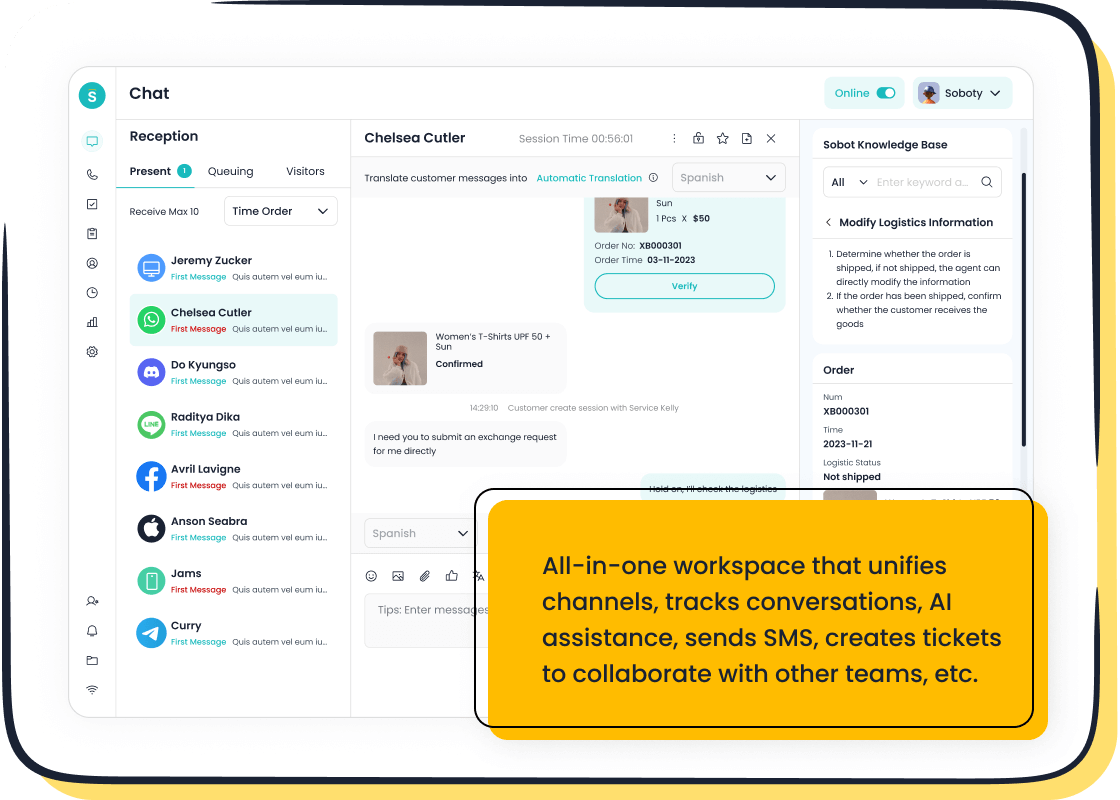
AI-Powered Personalization
Imagine walking into a store where every product feels tailored just for you. That’s the magic AI-powered personalization brings to customer engagement. These tools analyze customer preferences and predict behaviors, creating unique experiences that feel personal. For example, companies like Amazon use AI to recommend products, contributing to 35% of their annual sales. Similarly, Sephora’s AI-driven strategies have boosted engagement by 30% and conversions by 11%.
AI doesn’t just stop at recommendations. It can adapt conversations based on real-time data, making interactions feel natural and human-like. Businesses like HP Tronic have seen a 136% increase in conversions by leveraging AI-powered personalization. Whether it’s through tailored product suggestions or dynamic messaging, these tools make every interaction meaningful.
| Company | Metric Description | Result |
|---|---|---|
| HP Tronic | Increase in conversions | 136% increase |
| Amazon | Contribution of personalized recommendations | 35% of annual sales |
| Sephora | Increase in engagement and conversions | 30% engagement, 11% conversions |
| Yves Rocher | Jump in clicks and conversions | 17.5x clicks, 11x conversions |
AI-powered personalization isn’t just a trend—it’s the future of conversational AI. By understanding your customers better, you can deliver service that feels less robotic and more personal.
Multilingual and Omnichannel Support
In today’s globalized world, customers expect businesses to speak their language—literally. Multilingual support is no longer optional; it’s essential. Studies show that 64% of customers are willing to pay more for services that offer multilingual options. Even better, 73% of respondents say they’ll stay loyal to brands that provide this feature.
Omnichannel strategies take this a step further. They connect every interaction, whether it’s through chatbots, social media, or email, into one seamless experience. This approach reduces friction in the customer journey and boosts engagement across touchpoints. For instance, omnichannel tools ensure agents have full context, so customers don’t have to repeat themselves. This leads to faster resolutions and higher satisfaction.
| Statistic | Description |
|---|---|
| 65% | Consumers want to be treated valuably, and failure to meet this expectation leads to poor support experiences. |
| 64% | Customers are willing to pay more for services that offer multilingual support. |
| 73% | Respondents would remain loyal if their brand offers multilingual support. |
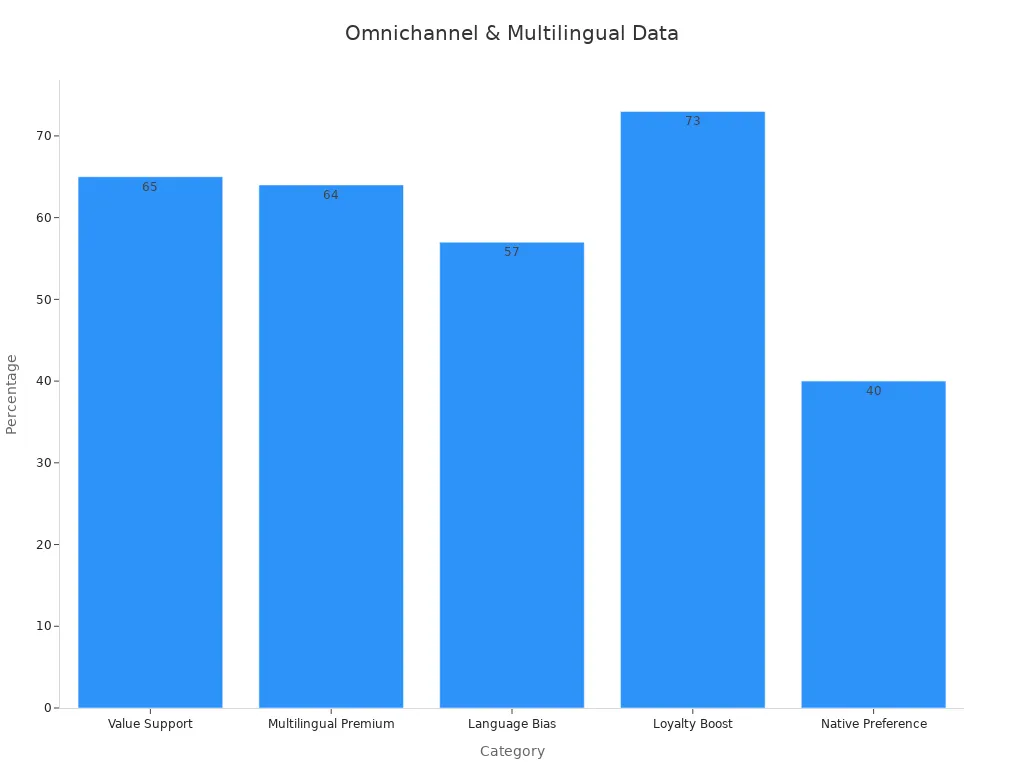
By combining multilingual capabilities with omnichannel strategies, you can create a customer experience that feels effortless and inclusive.
Integration with Emerging Technologies
AI chat tools are evolving fast, thanks to their integration with emerging technologies. Imagine a chatbot that not only answers questions but also uses augmented reality to show you how a product looks in your home. That’s the kind of innovation businesses are exploring.
Take H&M, for example. Their chatbot assists with product recommendations, sizing, and order tracking, creating personalized experiences that drive engagement and sales. Airlines like Delta use chatbots to provide flight updates, check-in assistance, and baggage tracking, improving efficiency and reducing wait times.
| Industry | Company | Chatbot Functionality | Impact on Customer Engagement |
|---|---|---|---|
| E-commerce | H&M | Assists with product recommendations, sizing, and order tracking | Increased engagement and sales through personalized experiences |
| Airlines | Delta Airlines | Provides flight information, check-in, and baggage updates | Improved operational efficiency and reduced waiting times |
Emerging technologies like augmented reality, voice recognition, and IoT are pushing the boundaries of what chatbots can do. These integrations make AI tools smarter, faster, and more versatile, ensuring your business stays ahead of the curve.
Focus on Data Security and Privacy
When you use artificial intelligence chat tools, keeping your customer’s data safe should be a top priority. These tools handle sensitive information like names, emails, and even payment details. If this data isn’t protected, it can lead to breaches that harm your business and erode trust. So, how can you ensure your AI tools are secure?
First, look for tools that offer encryption. Encryption scrambles data, making it unreadable to unauthorized users. This is a must-have feature for any chatbot or live chat service. It keeps your customer’s information safe during conversations and prevents hackers from accessing it.
Next, choose tools that comply with data protection laws like GDPR or CCPA. These regulations set strict rules for how businesses handle personal data. Tools that follow these laws show they take privacy seriously. Plus, compliance protects you from legal trouble.
Another way to boost security is by using AI tools with built-in privacy settings. For example, some chatbots let you control what data gets stored and for how long. This minimizes risks and ensures you’re only keeping what’s necessary.
Finally, train your team to handle data responsibly. Even the best AI tools can’t protect customer information if your team isn’t careful. Teach them to recognize phishing attempts and follow security protocols.
Pro Tip: Regularly update your AI tools to patch vulnerabilities. Outdated software can be an easy target for cyberattacks.
By focusing on data security and privacy, you create a safe environment for your customers. This builds trust and keeps your business running smoothly. After all, a secure chatbot isn’t just a tool—it’s a promise to your customers that their information is in good hands.
Chatbots and live chat tools have revolutionized how businesses engage with customers, offering faster service, higher satisfaction, and increased efficiency. Whether it’s the 73% of consumers who find live chat the most satisfying communication mode or the 48% revenue boost per chat hour, these tools deliver measurable results. From Sobot’s omnichannel support to ManyChat’s social media prowess, each tool brings unique benefits to the table.
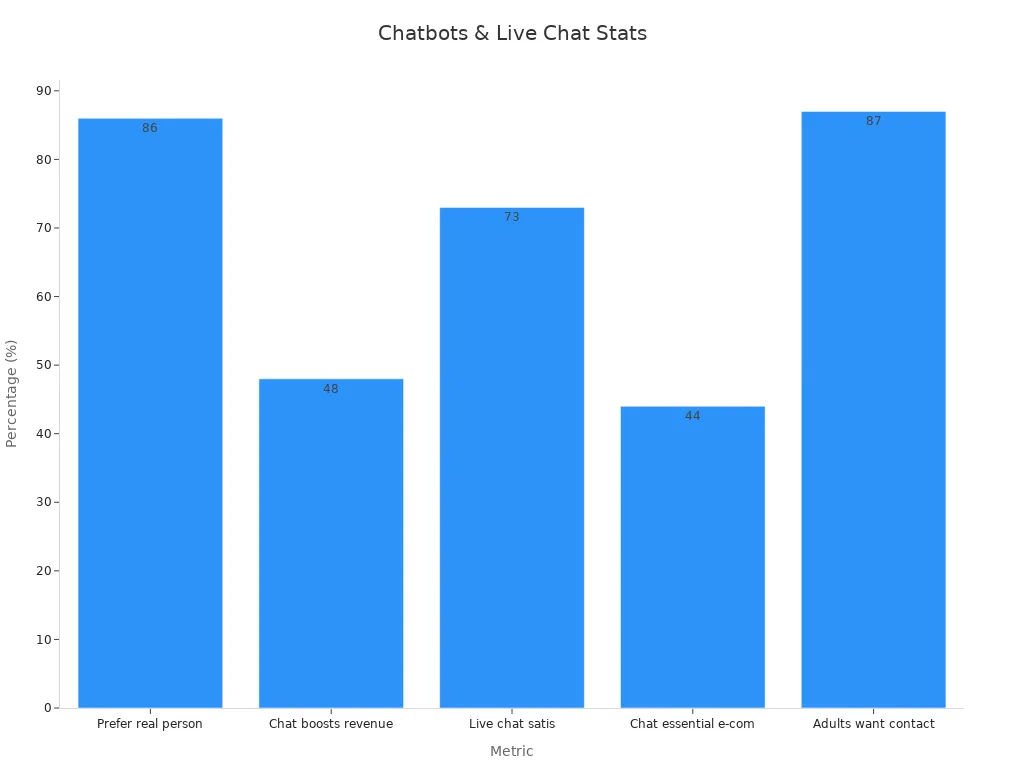
Take the time to evaluate your needs and choose the right solution. The right tool can transform your customer interactions and drive your business forward.
FAQ
What’s the difference between a chatbot and live chat?
Chatbots are automated tools that handle simple queries 24/7. Live chat connects you with a human agent for personalized support. Think of chatbots as your first line of help, while live chat steps in for complex issues. Together, they create a seamless customer experience.
Can I use both chatbots and live chat together?
Absolutely! Combining both tools gives you the best of both worlds. Chatbots handle repetitive tasks, while live chat agents tackle more nuanced questions. This hybrid approach improves efficiency and ensures your customers always get the help they need.
How do chatbots improve customer engagement?
Chatbots engage customers by providing instant responses, personalized recommendations, and proactive updates. They’re available 24/7, so your customers never have to wait. Plus, they can handle multiple queries at once, making your support faster and more efficient.
Are chatbots expensive to implement?
Not necessarily! Many platforms, like Sobot, offer scalable pricing plans to fit your budget. Some even provide free trials, so you can test their features before committing. Chatbots often save money in the long run by reducing operational costs.
How do I know which tool is right for my business?
Start by identifying your goals. Do you need 24/7 support? Go for a chatbot. Want personalized interactions? Live chat is your answer. If you’re unsure, try a free trial or demo to see which fits your needs better.
Pro Tip: Tools like Sobot combine both chatbots and live chat, giving you a flexible solution for all your customer engagement needs.
See Also
Enhancing Customer Satisfaction Through Chatbots in E-commerce
Best Live Chat Tools for E-commerce This Year
Comparative Review of Live Chat Solutions for 2024
